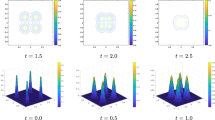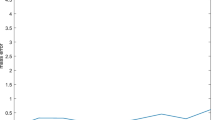Abstract
In this paper, an efficient characteristic difference domain decomposition method for solving the time-fractional order convection–diffusion equations is developed. A three-step method is used to solve the solution over non-overlapping sub-domain at every time interval. The new solutions are first solved by the the quadratic interpolation. Then, the intermediate fluxes on the interfaces of sub-domains are computed by local multi-point weighted average from the above new solutions. Finally, the solutions and fluxes in the interiors of sub-domains are computed by the implicit characteristic difference method, while the time fractional derivative is approximated by L1-format. By combining the operator splitting technique, we further propose an efficient splitting domain decomposition method for solve the two-dimensional problems. By some auxiliary lemmas, the stability and error estimate are given in discrete \(L^2\)-norm. We further prove that our scheme is of second-order convergence in space and of first-order convergence in time. Numerical experiments are presented to validate theoretical result.



Similar content being viewed by others
Data availability
Not applicable.
References
Alikhanov A (2015) A new difference scheme for the time fractional diffusion equation. J Comput Phys 280:424–438
Cao G, Sun H, Sun Z (2015) Stability and convergence of finite difference schemes for a class of time-fractional sub-diffusion equations based on certain superconvergence. J Comput Phys 280:510–528
Chen M, Deng W (2014) Fourth order accurate scheme for the space fractional diffusion equations. SIAM J Numer Anal 52:1418–1438
Chen C, Liu H, Zheng X, Wang H (2020) A two-grid MMOC finite element method for nonlinear variable-order time-fractional mobile-immobile advection-diffusion equations. Comput Math Appl 79:2771–2783
Deng W, Li B, Tian W, Zhang P (2018) Boundary problems for the fractional and tempered fractional operators. Multiscale Model Simul 16:125–149
Deng W, Wang X, Zhang P (2020) Anisotropic nonlocal diffusion operators for normal and anomalous dynamics. Multiscale Model Simul 18:415–443
Ding H, Li C, Chen Y (2015) High-order algorithms for Riesz derivative and their applications (II). J Comput Phys 293:218–237
Du Q, Mu M, Wu Z (2001) Efficient parallel algorithms for parabolic problems. SIAM J Numer Anal 39:1469–1487
Du Q, Gunzburger M, Lehoucq R, Zhou K (2012) Analysis and approximation of nonlocal diffusion problems with volume constraints. SIAM Rev 54:667–696
Feng L, Zhuang P, Liu F, Turner I, Gu Y (2016) Finite element method for space-time fractional diffusion equation. Numer Algorithm 72:749–767
Fu K, Liang D (2016) The conservative characteristic FD methods for atmospheric aerosol transport problems. J Comput Phys 305:494–520
Fu K, Liang D (2017) The time second order mass conservative characteristic FDM for advection-diffusion equations in high dimensions. J Sci Comput 73:26–49
Fu K, Liang D (2019) A mass-conservative temporal second order and spatial fourth order characteristic finite volume method for atmosphertic pollution advection diffusion problems. SIAM J Sci Comput 41:1178–1210
Gao G, Sun Z, Zhang H (2014) A new fractional numerical differentiation formula to approximate the Caputo fractional derivative and its applications. J Comput Phys 259:33–50
Hang T, Zhou Z, Pan H, Wang Y (2023) The conservative characteristic difference method and analysis for solving two-sided space-fractional advection-diffusion equations. Numer Algorithms 92:1723–1755
Jia J, Wang H (2015) A preconditioned fast finite volume scheme for a fractional differential equation discretized on a locally refined composite mesh. J Comput Phys 299:842–862
Jia J, Wang H (2016) A fast finite volume method for conservative space-fractional diffusion equations in convex domains. J Comput Phys 310:63–84
Jiang W, Liu N (2017) A numerical method for solving the time variable fractional order mobile-immobile advection-dispersion model. Appl Numer Math 119:18–32
Kamran K, Irfan M, Shah K et al (2023) RBF-Based local meshless method for fractional diffusion equations. Fract Fract. https://doi.org/10.3390/fractalfract7020143
Khan A, Shah K, Abdeljawad T, Sher M (2022) On fractional order Sine-Gordon equation involving nonsingular derivative. Fractals. https://doi.org/10.1142/S0218348X23400078
Koyunbakan H, Shah K, Abdeljawad T (2023) Well-posedness of inverse Sturm-Liouville problem with fractional derivative. Qual Theory Dyn Syst 22:23
Li X, Rui H (2017) A two-grid block-centered finite difference method for the nonlinear time-fractional parabolic equation. J Sci Comput 72:863–891
Li C, Yuan Y (2009) A modified upwind difference domain decomposition method for convection-diffusion equations. Appl Numer Math 59:1584–1598
Li R, Zhou Z, Li L (2020) The mass-preserving domain decomposition scheme for solving three-dimensional convection-diffusion equations. Math Comput Simulat 177:527–555
Li B, Liang H, He Q (2021) Multiple and generic bifurcation analysis of a discrete Hindmarsh–Rose model. Chaos Solit Fract 146:110856
Li B, Liang H, Shi L, He Q (2022) Complex dynamics of Kopel model with nonsymmetric response between oligopolists. Chaos Solit Fract 156:111860
Liu Z, Li X (2016) A parallel CGS block-centered finite difference method for nonlinear time-fractional parabolic equation. Comput Methods Appl Mech Eng 308:330–348
Liu F, Zhuang P, Turner I, Burrage K, Anh V (2014) A new fractional finite volume method for solving the fractional diffusion equation. Appl Math Model 38:3871–3878
Ma K, Sun T (2018) A non-overlapping DDM combined with the characteristic method for optimal control problems governed by convection-diffusion equations. Comput Optim Appl 71:273–306
Nie D, Sun J, Deng W (2020) Numerical algorithm for the model describing anomalous diffusion in expanding media. ESAIM Math Model Numer Anal 54:2265–2294
Roul P, Rohil V (2022) A novel high-order numerical scheme and its analysis for the two-dimensional time-fractional reaction-subdiffusion euqation. Numer Algorithms 90:1357–1387
Salomoni V, De Marchi N (2022) Numerical solutions of space-fractional advection-diffusion-reaction equations. Fractal Fract 6:21
Salomoni V, De Marchi N (2022) A fractional approach to fluid flow and solute transport within deformable saturated porous media. Int J Comput Mater Sci Eng 11:2250003
Shah K, Abdeljawad T (2023) Study of a mathematical model of COVID-19 outbreak using some advanced analysis. Waves Random Complex Media. https://doi.org/10.1080/17455030.2022.2149890
Shah K, Abdalla B, Abdeljawad T, Gul R (2023) Analysis of multipoint impulsive problem of fractional-order differential equations. Bound Value Probl. https://doi.org/10.1186/s13661-022-01688-w
Shah K, Abdeljawad T, Jarad F, Al-Mdallal Q (2023) On nonlinear conformable fractional order dynamical system via differential transform method. Comput Model Eng Sci 136:1457–1472
Shi H, Liao H (2006) Unconditional stability of corrected explicit/implicit domain decomposition algorithms for parallel approximation of heat equations. SIAM J Numer Anal 44:1584–1611
Simmons A, Yang Q, Moroney T (2017) A finite volume method for two-sided fractional diffusion equations on non-uniform meshes. J Comput Phys 335:747–759
Tian W, Zhou H, Deng W (2015) A class of second order difference approximations for solving space fractional diffusion equations. Math Comput 84:1703–1727
Vong S, Lyu P, Chen X et al (2015) High order finite difference method for time-space fractional differential equations with Caputo and Riemann-Liouville derivatives. Numer Algorithms 72:195–210
Wang H, Yang D (2013) Wellposedness of variable-coefficient conservative fractional elliptic differential equations. SIAM J Numer Anal 51:1088–1107
Wu X, Deng W, Barkai E (2016) Tempered fractional Feynman–Kac equation: theory and examples. Phys Rev E 93:032151
Yuan G, Sheng Z (2004) Stability and convergence of the explicit-implicit conservative domain decomposition procedure for parabolic problems. Comput Math Appl 47:793–801
Zeng F, Zhang Z, Arniadakis G (2015) A generalized spectral collocation method with tunable accuracy for variable-order fractional differential equations. SIAM J Sci Comput 37:2710–2732
Zhang H, Liu F, Phanikumar M, Meerschaert M (2013) A novel numerical method for the time variable fractional order mobile-immobile advection-dispersion model. Comput Math Appl 66:693–701
Zhang J, Yang D, Guo H et al (2017) Parallel algorithm combined with mixed element procedure for compressible miscible displacement problem. Numer Algorithms 76:1–27
Zhang J, Yang D, Zhu J (2018) Parallel characteristic mixed element method for saltwater intrusion problem. J Comput Appl Math 336:160–174
Zhou Z, Liang D (2017) The mass-preserving and modified-upwind splitting DDM scheme for time-dependent convection diffusion equations. J Comput Appl Math 317:247–273
Zhou Z, Liang D, Wong Y (2018) The new mass-conserving S-DDM scheme for two-dimensional parabolic equations with variable coefficients. Appl Math Comput 338:882–902
Zhou Z, Sun X, Pan H, Wang Y (2020) An efficient characteristic finite difference S-DDM scheme for convection-diffusion equations. Comput Math Appl 80:3044–3065
Zhuang Y, Sun X (2002) Stabilized explicit-implicit domain decomposition methods for the numerical solution of parabolic equations. SIAM J Sci Comput 24:335–358
Acknowledgements
This work was supported by Natural Science Foundation of China (Grant No. 61703250), Natural Science Foundation of Shandong Government (Grant No. ZR2021MA002), and Shandong Agricultural University (Grant No. xxxy201704).
Author information
Authors and Affiliations
Corresponding author
Ethics declarations
Conflict of interest
The authors declare no competing interests.
Additional information
Publisher's Note
Springer Nature remains neutral with regard to jurisdictional claims in published maps and institutional affiliations.
Rights and permissions
Springer Nature or its licensor (e.g. a society or other partner) holds exclusive rights to this article under a publishing agreement with the author(s) or other rightsholder(s); author self-archiving of the accepted manuscript version of this article is solely governed by the terms of such publishing agreement and applicable law.
About this article
Cite this article
Zhou, Z., Wang, N., Pan, H. et al. The characteristic difference DDM for solving the time-fractional order convection–diffusion equations. Comp. Appl. Math. 42, 289 (2023). https://doi.org/10.1007/s40314-023-02429-0
Received:
Revised:
Accepted:
Published:
DOI: https://doi.org/10.1007/s40314-023-02429-0




